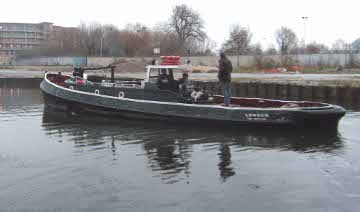THE well-known historic 42ft dock tug Major revisited Essex Wharf at Lea Bridge at the weekend, on a nostalgic trip up the Lee Navigation.
Over the years it had towed hundreds of trains of barges to numerous destinations on the busy navigation, and at the time when Essex Wharf was a hive of activity, writes Del Brenner of the Regents Network, who is campaigning with many others for Essex Wharf to be rescued from property development and brought back into use as a much needed strategic wharf for London.
Secretary of State
The fate of the wharf still lies in the hands of the Secretary of State since the planning application for four huge blocks of flats was called-in after it received the unwelcome consent from Waltham Forest planning committee. Perhaps the Secretary of State would benefit from a visit to Essex Wharf on Major to see for himself.
 While the Secretary of State thinks about the future of Essex Wharf from his office in Victoria Street, he is being strongly lobbied from a number of directions including the CBOA Commercial Boat Operators Association, The Lee Valley Regional Park, factions in the GLA, the Lee Valley Federation, local councillors, the London Borough of Hackney and various well-organised local groups.
While the Secretary of State thinks about the future of Essex Wharf from his office in Victoria Street, he is being strongly lobbied from a number of directions including the CBOA Commercial Boat Operators Association, The Lee Valley Regional Park, factions in the GLA, the Lee Valley Federation, local councillors, the London Borough of Hackney and various well-organised local groups.
Swept aside
They greatly outnumber the supporters of the residential development which was all too apparent at the planning stage but were swept aside by the borough's planners.
A very strong case is being made for Essex Wharf to be brought back into use for water freight, as well as a leisure amenity and an active asset to the Regional Park's waterways.
Interest in reviving the wharf also comes from the crew of Major, and the tug was skippered on the visit to Essex Wharf by James Bill of busy coal boat Archimedes from the Candlebridge Carrying Co, and Michael Askin of the magnificent Royal Class working boat Victoria.
Unused and deserted wharf
Standing on the back deck viewing the unused and deserted wharf is experienced waterman Jamie Spinks who served his apprenticeship on Major when it was heavily engaged in the construction period of Canary Wharf in London's Docklands.
Jamie may also be thinking of the regular runs made by the tug up the Lee Navigation when Essex Wharf was very alive, and comments:
"Those were the days when London's canals were made good use of and there is every reason for bringing them back into use again. It is a mystery that it has not happened."
Use the wharf again
Apart from ruining the pleasure of a cruise up the waterway having four huge blocks of flats on the site of Essex Wharf rather than a view of Walthamstow Marshes, it would be nonsensical not to use it as a wharf again. The waterway is in working order, the roads are chocker, and the environmental benefits of using water transport are well known. Jamie is not the only one who thinks it does not make any sense.
Commonsense use of the waterways runs in Jamie's family, and the photo shows the tug Major in 1962 under its original name Valkirie when it was part of the Vokins fleet, being skippered by his grandfather Henry Vincent.
Still going strong
 The tug with its powerful Gardner 6L3 engine (still going strong) is towing heavily laden barge Leetrout with two more barges behind. The barges had just come through Bow Locks with a load of timber from Surrey Commercial Docks and the photo is shot from Three Mills bridge where there is now a Tesco supermarket on the right in place of the industrial buildings.
The tug with its powerful Gardner 6L3 engine (still going strong) is towing heavily laden barge Leetrout with two more barges behind. The barges had just come through Bow Locks with a load of timber from Surrey Commercial Docks and the photo is shot from Three Mills bridge where there is now a Tesco supermarket on the right in place of the industrial buildings.
Timber by the megatons was shipped up the Lee Navigation, in particular for the world famous furniture-making trade, and this load was heading for one of the numerous timber yards such as Lathams Timber that stood on the opposite bank to Essex Wharf, and which has recently suffered the fate of property development that is threatened for Essex Wharf.
Came a cropper—again
Although the canals are in working order, they are in urgent need of a bit of maintenance, which will have to include a certain amount of dredging up the Lee Navigation.
 Major came off the Thames into Limehouse Basin, and had set out from the basin into the Limehouse Cut up to Bow. However, it got no further than 50 yards when an interior sprung mattress was picked up by the large three-bladed prop, and which took over an hour to remove using ropes and a winch which James had to attach to the mattress springs by entering the freezing water.
Major came off the Thames into Limehouse Basin, and had set out from the basin into the Limehouse Cut up to Bow. However, it got no further than 50 yards when an interior sprung mattress was picked up by the large three-bladed prop, and which took over an hour to remove using ropes and a winch which James had to attach to the mattress springs by entering the freezing water.
What a welcome back to the Lee Navigation for the historic tug!
Del Brenner, Regents Network and a member of the London Waterways Commission.
